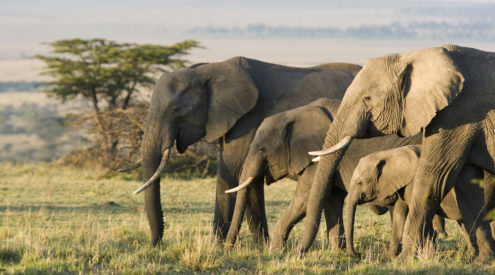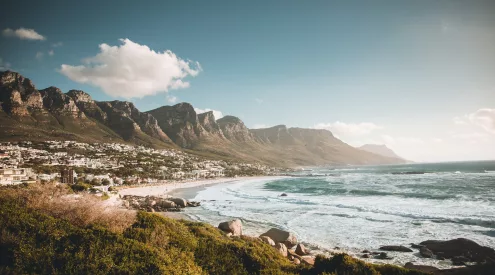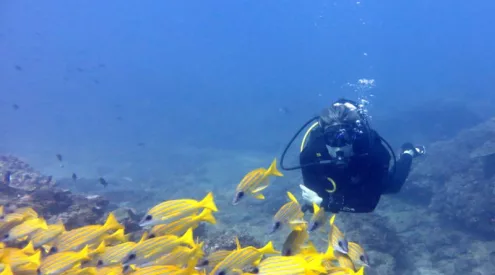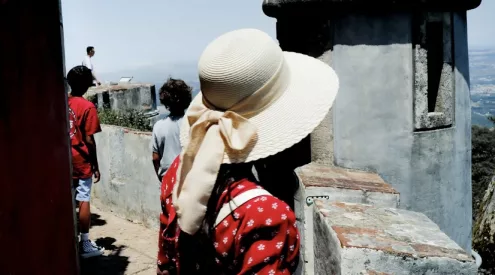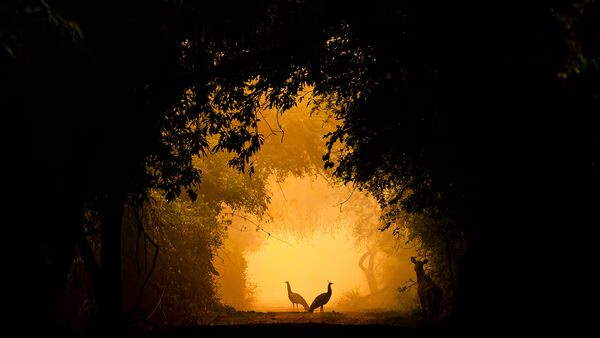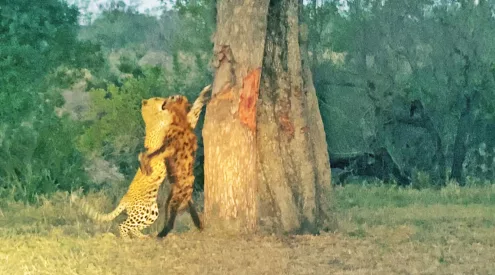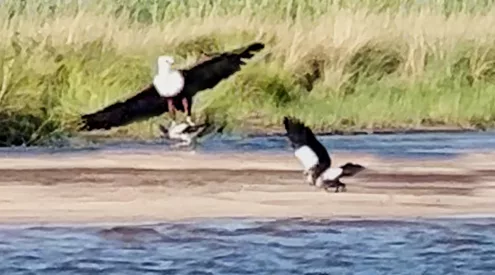The Boeing 727 bumps down onto the runway at Jomo Kenyatta Airport in Kenya. A very uncomfortable journey is finally at an end. At Jomo Kenyatta, for some inexplicable reason, those convenient connection bridges, although there, are not used to make life easier for passengers, instead we are directed to the tarmac.
Thankfully it is not so hot, but the fact that we have our camera equipment in a bag with wheels is rendered completely superfluous as we are faced with several flights of stairs. However, the check out through customs is seamless, as is our transfer. Wilson Airport is the next stop and thereafter a short flight to Olkiombo airstrip puts us firmly on Masai Mara territory without any hitches.
Over the years of animal observation the number of reference books in my library has grown and many hours are spent checking on facts and figures to ensure more informed game viewing. A qualified ranger/guide is also one of the essential luxuries that make my trips all the more interesting as certain behaviour can be checked and discussed as it takes place. But June 2011 provides the platform for the animals of the Masai Mara to turn the tables and make up their own rules in contrast to the recorded facts.
Not a complete record breaker, a female cheetah (named Shingo) last year produced6 fluffy little cubs. (The record number of cubs it appears is 8).What, however, is record breaking is that almost one year later, in among lion territory, Shingo and her progeny are alive and well. She has learnt to hunt with vehicles swarming around her and quite frankly, if I were her, come this season of the wildebeest I would head for the hills where vehicles cannot go. During our 6-day stay, we are lucky enough to see the whole group three times. I forgo a fourth sighting on the morning of our departure in case there is a lot of action and I can’t tear myself away.
The group, however, do provide us with a showstopper on one morning as we are following them. It is obvious that they are on the move. There was no meal the day before and such a large family needs to eat regularly. As we move north from the Talek Gate area, the ever-present vehicles move along with the pack and as the cats gracefully move from vantage point to vantage point the inevitable crossing of paths eventuates. This time, however, instead of the cats ignoring the vehicles the cubs become curious, and before anyone can click their fingers there is an adolescent cheetah inside one of the open vehicles. Definite footage for a ‘caught in the act’ moment! The driver of the vehicle has to grit his teeth and freeze while a wild cheetah investigates the interior using him as a footing. Much nervous laughter follows this incident but methinks this will be repeating itself throughout the years to come.
It is rainy season in the Mara and huge thunderstorms with bolts of lightning fill the skies each evening. On one such night a buffalo mysteriously dies next to the Talek River. We approach the scene early in the morning and the hyenas have already claimed the prize. Speculation about the whys and the wherefores take place, as an avid vulture fan I am anxious to hang around for the vultures that would inevitably land on the kill as soon as the air heats up. This is what the rule books say. However, we are proved wrong again. The vultures circle but they leave again. On our third or fourth passing of the scene there is a leopard lying next to the carcass under a tree. Incredulously, as we position ourselves for good photographs, we witness the leopard lazily rise from his sleeping place, saunter on over to the carcass and start to feed. Jaw dropping stuff! The temptation, of course, is to pass this photograph off as a leopard kill of note, but even the truth is just as unbelievable. The leopard is not desperate for food but decides to throw out the rule books and feed on carrion.
The leopards of the Talek River do not stop there. In the immediate area around the incident there are at least 4 leopards who currently share the same space: 2 sister leopards who share the responsibilities of raising a cub, and the male leopard we saw at the kill. This unusual sight certainly puts substance to ‘never say never!’
Lions do not climb trees (or so the rule books say), but there is an area in Tanzania that boasts the unusual attraction of lions in trees. A visit to the Serengeti at the beginning of the year presented a superb photographic opportunity as we viewed 3 lionesses with a cub in a tree. It was the ultimate end to a safari and definitely a once-in-a-lifetime event.
But, not to be outdone, the Masai Mara produces an equaliser: 4 lionesses have decided that a tree is a preferable hang out to lying in the wet grass. And, just to prove it isn’t something they occasionally do, we see them in the tree 3 days in a row.
This is just the beginning of the lion saga of the Mara of 2011. In the same area that is just south of the Talek River we meet the Notch Pride. A bunch of boys, who will soon be very famous, thanks to a Disney film that has just been released. The Notch Pride consists of a father and his 4 sons who have now taken over a huge area of the Mara. They do not live with the lionesses like other lions and appear to be servicing about 3 prides of females in separate locations. To add to the aberration they also hunt for their own meals. Yes, they hunt for themselves! Strange but true.
Two nights before the end of this very unusual trip the Notch Boys take down an adult hippo and we are witness to yet more unusual behaviour. At the time, one of the boys is taking his turn with a lioness, the lioness then allows each of the boys to take turns with her (a real tart). On our first sighting of the mating ritual I note that this is the same lioness I photographed mating in September the previous year. The conclusion is that she did not produce any offspring and is trying again. Then, the next day we see her again and she has another of the brothers doing the honours. To add to this, once the hippo kill becomes a meal, this pair decides to take a break and have a snack.
Later that morning we notice that another lioness has joined the group and another mating session starts. At one stage I have both my cameras pointing in opposite directions to try capture this bizarre scene: 1 flailed hippo lying on its side with its intestines spilling out; 2 black-backed jackals darting in and out of the bush; 2 vultures bouncing around on the outer edge of the scene; 1 marabou stork standing by; 2 lions sleeping in close proximity to the kill to ensure that no intruder gets their food; 1 lion lying sleeping a little further away; and 2 pairs of mating lions all within 100 metres of each other!
Our flight leaves Olkiombo at 4 pm, and as we fly north towards the next airstrip we fly over Shingo and her cubs on the move again, and I cannot help but think that this was a safari of surprises. Perhaps there was something strange in the water or perhaps we can blame global warming!




